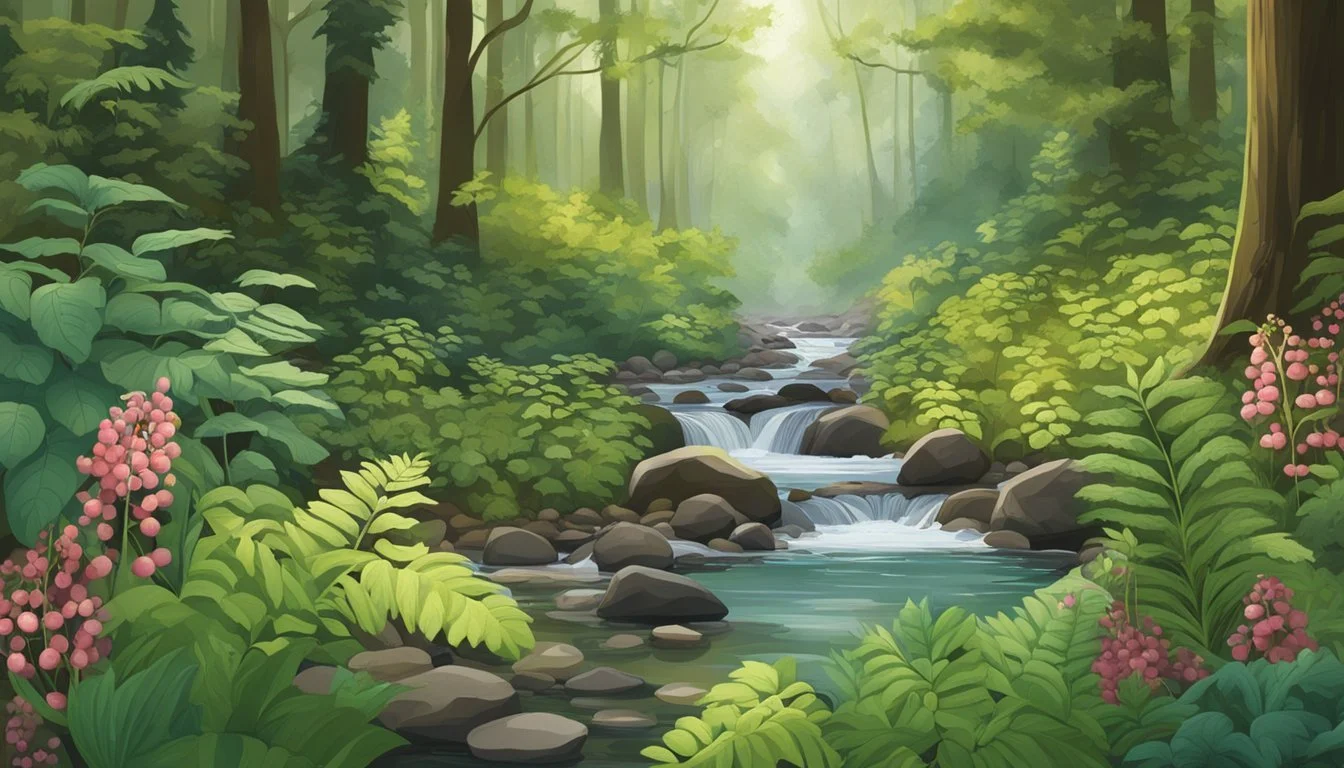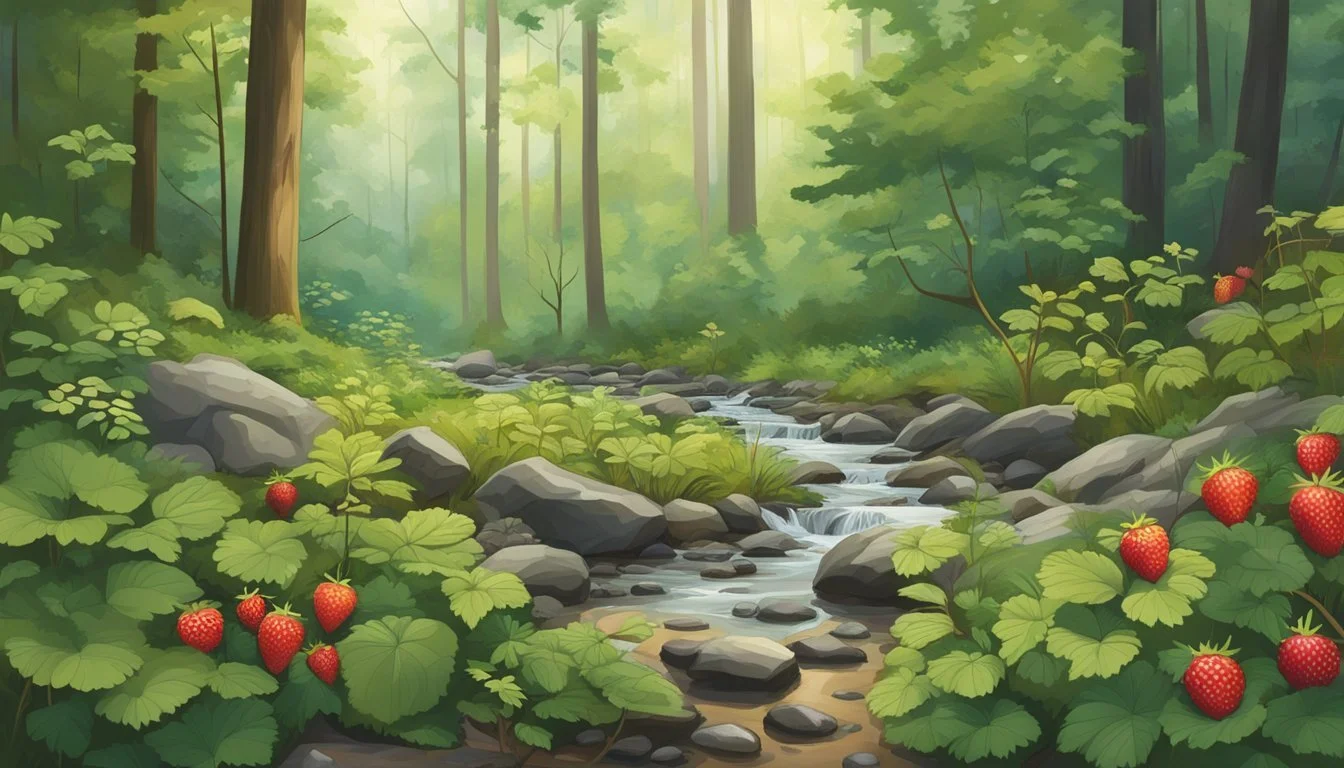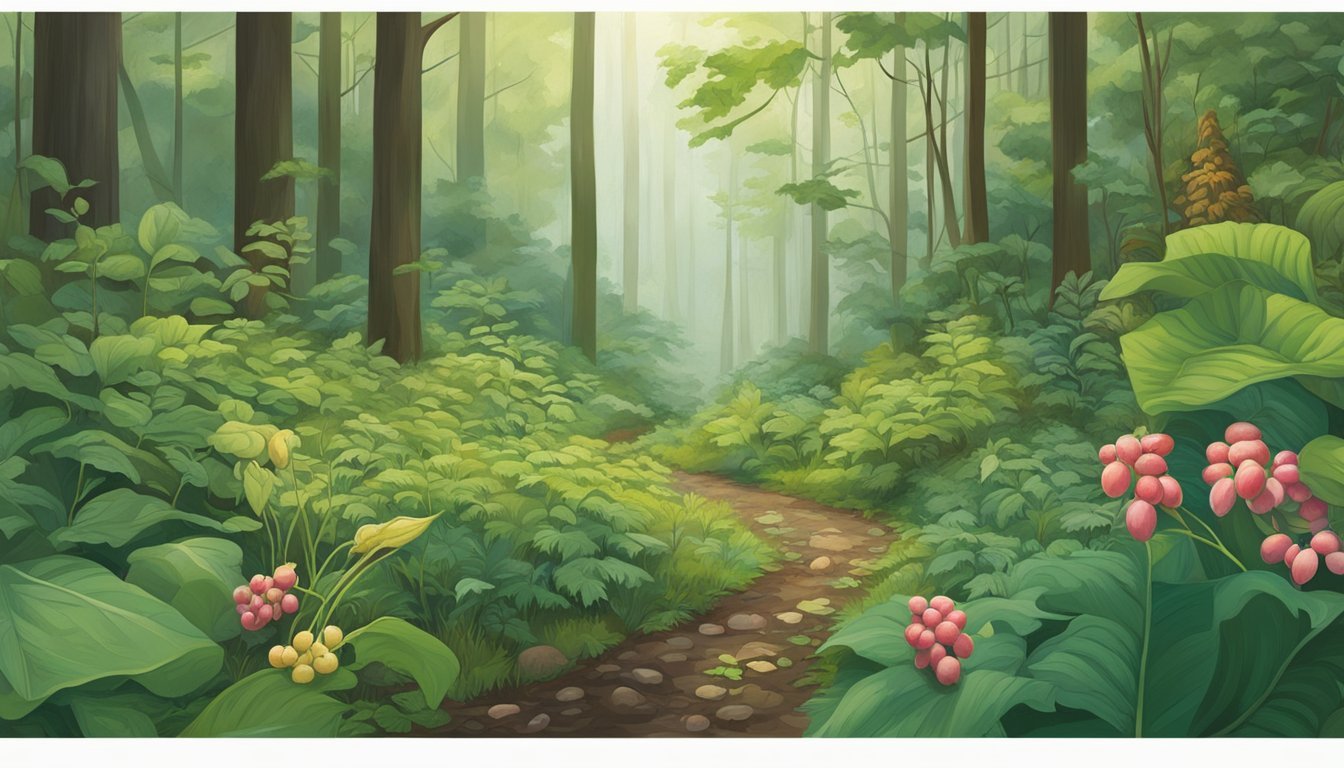Native Edible Plants in Maryland
A Guide to Foraging Local Flora
This Article is Part of Foraging Guide for All 50 US States
Maryland's diverse ecosystems—from the Appalachian Mountains to the Chesapeake Bay—create an abundance of native edible plants. These naturally occurring flora not only represent an important part of the region's biological heritage but also offer a variety of flavors and nutritional benefits. Many of these species have served as traditional food sources for indigenous peoples, and they continue to be valued for their culinary potential and ecological significance.
The state's temperate deciduous forests, coastal estuaries, and inland wetlands are home to an array of edible plants. Pawpaw trees, with their custard-like fruit, thrive in the understory of Maryland's woodlands, while the spicebush, recognized by its aromatic leaves and berries, adds zest to local recipes. Wild berries, including blackberries (how long do blackberries last?), blueberries, and raspberries, abound in Maryland's natural spaces, each berry seasonal in its own right and eagerly foraged by those aware of their habitats.
Understanding the characteristics and habitats of these plants is crucial for proper identification and sustainable harvesting. It is important that those who forage for these plants do so with respect for the environment and an understanding of conservation principles to ensure these species continue to flourish for generations to come. This exploration of Maryland's native edible plants will examine the varieties available throughout the state, their culinary uses, and the best practices for foraging sustainably.
Interested in Mushroom Hunting in Maryland?
Maryland's diverse landscapes, from the Appalachian Mountains to the Chesapeake Bay, offer prime habitats for mushroom hunting. The state boasts a variety of edible species, including morels, chanterelles, and oyster mushrooms. With proper identification skills and respect for public and private land regulations, foraging in Maryland promises a rewarding and exciting adventure.
👉 Guide on Mushroom Hunting in Maryland
Historical Context of Foraging in Maryland
Foraging in Maryland has deep historical roots that intertwine with both the cultural fabric and economic frameworks of the region.
Cultural Significance
In Maryland, native plants such as the pawpaw (Asimina triloba), American persimmon (Diospyros virginiana), and various wild berries have been integral to local diets for centuries. For the indigenous tribes, including the Piscataway and the Susquehannock, these plants served not only as food sources but also held medicinal and spiritual importance. Foraging, as a skill, was passed down through generations as an essential aspect of living harmoniously with nature.
Economic Impact
17th to 19th centuries:
Fur trade: Major economic driver, linked to foraging knowledge.
Agriculture: Expansion reduced reliance on wild plants.
With the arrival of European settlers in the 17th century, the foraging landscape began to transform. Native plants continued to be foraged for sustenance; however, the settlers also introduced new agricultural practices that eventually altered the economy. Foraging, which was once a primary means of obtaining food, started to become supplementary to farming.
During the colonial period, the knowledge of native plants contributed to the fur trade, as foraged foods often supported trappers and traders on their expeditions. The value placed on foraged goods was significant enough to influence the local economies of Maryland's early settlements.
Understanding Native Edible Plants
In Maryland, native edible plants offer significant ecological benefits and exhibit distinctive seasonal behaviors.
Defining Native Species
Native plants in Maryland refer to species that have naturally existed in the region for thousands of years. These are not introduced species but ones that have evolved with the local climate, soil, and other native species. Native edible plants include varieties such as the pawpaw (Asimina triloba), persimmon (Diospyros virginiana), and wild berries like blackberries.
Benefits to Ecosystems
Maryland's ecosystems reap substantial rewards from the presence of native edible plants. These plants have deep-rooted connections with the local pollinators, providing essential food sources and habitats. By bearing fruits and seeds, they serve as vital nutrition sources for wildlife. Moreover, they contribute to soil health and prevent erosion. For instance:
Summer: Plants like the common milkweed (Asclepias syriaca) bloom and attract a range of insects, including butterflies and bees, which are crucial pollinators in natural resource cycles.
Winter: The American holly (Ilex opaca) provides shelter and berries for birds during the scarce winter months.
Seasonal Variations
Seasonal changes greatly influence the availability and type of native edible plants in Maryland. The table below outlines some examples:
Season Native Edible Plants Characteristics Summer Wild berries, Pawpaw Summer fruiting provides food for humans and animals alike. Winter American Holly, Nuts Winter plants offer persistent resources in barren months.
During summer, the native edible plants are at their peak productivity, yielding fruit and seeds for consumption by humans and animals. Winter forces plants into dormancy, but some, like the American holly, still provide critical resources.
Identifying Edible Plants
Accurate identification of edible plants is crucial for foragers and nature enthusiasts in Maryland. This section provides guidance on recognizing various edible plant parts, such as leaves, herbs, fruits, berries, roots, and tubers.
Leaves and Herbs
Maryland woods and fields are home to a variety of edible leaves and herbs. Wood sorrel is easily identifiable by its heart-shaped, clover-like leaves and can be recognized by its distinct tart flavor. Foragers can also find wild garlic, which has flat, grass-like leaves. Always ensure plants are free of pesticides and pollutants before consumption.
Wood Sorrel
Leaves: Heart-shaped, resembling clover
Flavor: Tart, lemony
Wild Garlic
Leaves: Flat, long, and grass-like
Scent: Pungent, garlic-like
Fruits and Berries
Edible fruits and berries are abundant in Maryland. One can spot black cherry trees by their clusters of small, dark, globe-shaped fruits, and blueberries, which feature round blue-purple berries growing on perennial shrubs.
Black Cherry (Prunus serotina)
Fruit: Small, dark purple to black, slightly tart
Trees: Medium-sized, often with rough, flaky bark
Blueberries (Vaccinium spp.)
Berries: Blue to purple, sweet when ripe
Shrubs: Deciduous or evergreen, depending on species
Roots and Tubers
Roots and tubers require careful identification, as it can be a challenge to distinguish edible varieties from those that are toxic. The Jerusalem artichoke is an edible tuber, not to be confused with the toxic plants. Proper knowledge and identification guides are strongly recommended for these plant components.
Jerusalem Artichoke (Helianthus tuberosus)
Tubers: Knobby, similar to ginger root, nutty flavor
Plant: Tall, with yellow flowers resembling sunflowers
Legal and Ethical Foraging
Foraging for edible plants in Maryland must comply with regulations set by the Maryland Department of Natural Resources, and one should adhere to sustainable harvesting practices to preserve natural ecosystems.
Department of Natural Resources Guidelines
The Maryland Department of Natural Resources (DNR) emphasizes the importance of knowing and following the state's foraging laws. Foragers must:
Obtain necessary permits for foraging on public lands.
Adhere strictly to the areas and quantities specified by their permit.
Recognize and avoid foraging in protected areas where it is strictly prohibited.
Additionally, the DNR provides educational resources to help foragers identify legal foraging locations and protect native species.
Sustainable Harvesting Practices
When foraging, individuals must practice sustainable harvesting to minimize their impact on nature.
Key practices include:
Only taking a small, pre-defined percentage of available plants, generally accepted to be around 10-20%.
Harvesting in a manner that ensures plants can regenerate, such as taking only parts of the plant that will not prevent it from continuing to grow.
Avoiding the disturbance of surrounding plant life and wildlife habitats.
These actions help ensure that natural resources remain abundant for wildlife and future foragers.
Preparation and Usage of Edible Plants
When preparing and using edible plants in Maryland, one must be well-informed about their nutritional properties and the variety of ways they can be incorporated into daily meals.
Nutritional Information
Edible plants found in Maryland, such as wild chives (how long do chives last?) and garlic, are not only flavorful but also nutrient-rich. They offer a variety of vitamins and minerals, with a significant presence of iron, which is vital for blood health.
Chives (Allium schoenoprasum):
Iron: 1.6 mg per 100g
Vitamin C: 58.1 mg per 100g
Vitamin K: 212.7 mcg per 100g
Garlic (Allium sativum):
Iron: 1.7 mg per 100g
Vitamin C: 31.2 mg per 100g
Vitamin B6: 1.235 mg per 100g
These values highlight the importance of including such plants in the diet for their nutritional benefits.
Culinary Applications
In the culinary world, Maryland's native plants can transform ordinary dishes into extraordinary meals with their distinct flavors and health advantages. Wild chives can be snipped fresh over a salad, providing a mild onion flavor, while garlic can be roasted to enhance its sweetness and added to a variety of dishes from savory roasts to dips.
Salad with Chives:
Fresh garden salad greens
Sliced cucumber
Cherry tomatoes
Topping: Snipped wild chives
Dressing: Olive oil and vinegar
Roasted Garlic:
Preheat oven to 400°F (205°C).
Cut the top off the garlic bulb to expose the cloves.
Drizzle with olive oil and wrap in foil.
Roast for 30-35 minutes until cloves are soft and caramelized.
Use as a spread or in sauces.
By understanding the nutritional content and culinary applications, Maryland residents can make the most of these versatile and healthy edible plants.
Commonly Foraged Plants in Maryland
Maryland's various ecosystems are home to a diverse array of native plants, many of which are edible wildflowers, shrubs, and herbs. These plants provide foragers with opportunities to gather local, natural food sources.
Wildflowers and Shrubs
Wildflowers and shrubs are integral to Maryland's natural flora. Notable among these is the Eastern Columbine (Aquilegia canadensis), a native wildflower with distinctive red and yellow flowers. This plant, which is found across North America, supports local pollinators and can be seen in Maryland's wooded areas.
Another prominent shrub is Monarda (Monarda didyma), also known as Bee Balm. This plant is recognized by its vibrant red flowers and its ability to attract a variety of pollinators.
Wildflower/Shrub Description Habitat Eastern Columbine Red and yellow nodding flowers Woodlands Monarda Vibrant red flowers, aromatic Moist areas, meadows
These species not only beautify the landscape but can also be used in various culinary applications, from garnishes to flavorings.
Aromatic Herbs
In addition to wildflowers and shrubs, Maryland is home to a variety of aromatic herbs that are commonly foraged. Herbs such as wild mint and thyme can be discovered throughout the state, their fragrances filling the air in the areas where they grow.
The use of these herbs in culinary dishes adds a unique taste of Maryland's native landscape, providing fresh, local flavors to a variety of recipes. They can often be found in fields, edges of forests, and even alongside streams and rivers.
Aromatic Herb Description Uses Wild Mint Strong, refreshing scent Culinary, teas Thyme Small but potent leaves Seasoning for dishes
Foragers value these plants not only for their taste but also for their uses in traditional and herbal medicine.
Resources for Aspiring Foragers
Aspiring foragers in Maryland can access a variety of resources to enhance their knowledge and skills in identifying and harvesting native edible plants. They should prioritize education and safety to responsibly engage in foraging activities.
Books and Guides: Foragers may start with field guides such as "Edible Wild Plants: Eastern/Central North America" by Lee Allen Peterson. These guides provide detailed descriptions and illustrations helpful in plant identification.
Workshops and Classes: Local nature centers and organizations often host workshops. For example, the Maryland Native Plant Society conducts events that may include plant walks and educational talks on native species.
Organization Type of Resource Maryland Native Plant Society Workshops, Plant Walks Local Nature Centers Foraging Classes
Online Resources: Websites like EatTheWeeds.com provide extensive information on foraging, including articles about plants found in the Maryland region.
Maryland Department of Natural Resources (DNR): The DNR can provide guidelines and regulations for foraging in the state, ensuring sustainable practices. They also offer resources on plant conservation and responsible foraging.
Foraging Societies: Joining a foraging society or group can be invaluable for the exchange of knowledge and experiences. Members can participate in group forages, which can offer a safe introduction to foraging.
Foragers are advised to never consume a plant unless they are 100% certain of its identification and edibility. Responsible foraging not only protects the individual but also the environment and its native plant populations.




